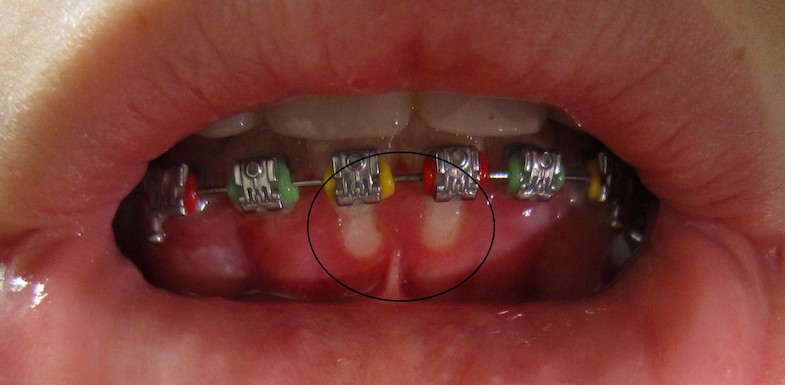Imagine a painful, chronic infection that has no cure and affects the majority of people worldwide. It is highly contagious and has few treatments beyond palliative care. Primary herpetic gingivostomatitis is that condition.
What is primary herpetic gingivostomatitis?
Primary herpetic gingivostomatitis (also referred to as orolabial herpes) is the first and often most painful iteration of cold sores. Caused by the HSV1 (herpes simplex virus type 1), this infection occurs in everyone from babies to older adults.
The sores that appear as a result of primary herpetic gingivostomatitis are circled in red and can be yellow or gray in the middle. Starting as multiple vesicles filled with fluid, they appear most frequently inside the mouth. The vesicles break open and form painful ulcers. Outbreaks can last for up to ten days, with sores that are irritated and itchy as they begin to heal.
After the appearance of primary herpetic gingivostomatitis, the following infections will most likely appear as cold sores outside of the mouth. It is important to note that neither cold sores not primary herpetic gingivostomatitis are caused by the same virus that causes genital herpes (herpes simplex virus type 2, or HSV2).
Primary herpetic gingivostomatitis symptoms
To begin, there is usually a prodromal phase where you may feel a prickling or burning sensation in the mouth and on the lips. This does not affect everyone, and babies or young children may not be able to explain or identify this symptom.
The most common symptoms include the following:
- Fever in the days leading up to an outbreak (and, in some cases, continuing through the outbreak)
- Swollen gums
- Bleeding gums
- Swollen lymph nodes
- Headache
- Fatigue
- Loss of appetite
- Sore throat
- Pain when swallowing
- Halitosis (bad breath)
- General malaise or feeling poorly
When this first outbreak occurs in children, they may experience vesicles not only in their mouth on their gums but also on their lips and cheeks. Lesions on the face may be incredibly painful. Young children and babies may also drool excessively, a symptom that is sometimes confused with the drooling associated with teething.
Diagnosis of this condition is simple. Once a lesion appears, your doctor swabs it and tests for the presence of the herpes simplex virus 1. While lesions may resemble other oral conditions, if HSV1 is present, it is diagnosed as primary herpetic gingivostomatitis.
Is primary herpetic gingivostomatitis contagious?
HSV1 is very common around the globe, with an estimated two-thirds of the population infected. HSV2 is less common, and the incidence of both appears to be decreasing.
Both viruses are highly contagious and often transmitted to babies via parents (or other babies). As babies tend to explore everything with their mouths first, if another infected baby has been playing with a toy, the virus is easily transmitted.
Likewise, babies can contract the virus by sharing eating utensils with an infected sibling or adult or from sucking their thumb.
How long does primary herpetic gingivostomatitis last?
The length of an outbreak varies, depending on the age of the patient and their general overall health, but most outbreaks last between seven and 14 days.
This does not include the prodromal phase which can start three or four days before lesions appear.
What are common herpetic gingivostomatitis treatments?
Especially for children, treatment is largely unnecessary, as most infections are mild and resolve themselves within a few days. Typically, treatment is also only effective if it is started within 72 hours of an outbreak.
If your child has an outbreak and is unable to eat or drink, palliative treatments to relieve pain can help. Dehydration is a common complication of this condition and can be dangerous for very young children.
Home remedies for primary herpetic gingivostomatitis
There are some home remedies that can relieve pain and shorten healing times.
For older children, rinsing the mouth with a hydrogen peroxide solution can help shorten healing times. Likewise, rinses that include food-grade essential oils such as tea tree oil, clove oil, and myrrh oil can help because of their natural antibacterial and antiviral properties. Mix these with a carrier oil like coconut oil before dabbing onto the lesions or swishing in the mouth.
Adding supplements of zinc, vitamin C and B-complex can help boost the immune system and speed healing as well. Further, avoid spicy or salty foods that may aggravate or irritate the lesions. Wash your hands (and your children’s hands) frequently, and avoid touching your face. Offer plenty of liquids to prevent dehydration.
Pain relief
For pain relief, ibuprofen or acetaminophen can be administered per your doctor’s instructions. Sometimes a warm washcloth pressed gently onto the sore can be soothing (babies may try to self soothe by chewing on textured fabrics, too).
Topical analgesics like Oragel can be dabbed on lesions that are painful but not open. Parents of babies can gently swab the gel on the affected areas.
Prescription medications for primary herpetic gingivostomatitis
As noted above, prescription medications have the best chance of working if they are administered within 72 hours of an outbreak. After that point, the body’s immune system takes over and medication is not necessary (and is generally ineffective).
The two most common prescription medications are oral rinses with 2% viscous xylocaine (lidocaine hydrochloride) and conventional antiviral therapy (e.g., acyclovir, valacyclovir, and penciclovir). You can use xylocaine before eating to relieve pain. The antiviral therapies can be taken orally for older children and adults, but younger children and babies can be treated with a topical solution.
Avoiding HSV1 is challenging, but you can limit your exposure. Do not share toothbrushes or eating utensils, even among family members. While you cannot sanitize everything your baby touches (especially when they are not with you!), make sure to wash your baby’s toys frequently in hot, soapy water.
AZ Dentist is your Phoenix area family dentist. If you or someone in your family is experiencing painful lesions, get in touch today. Our compassionate dentists can help.
